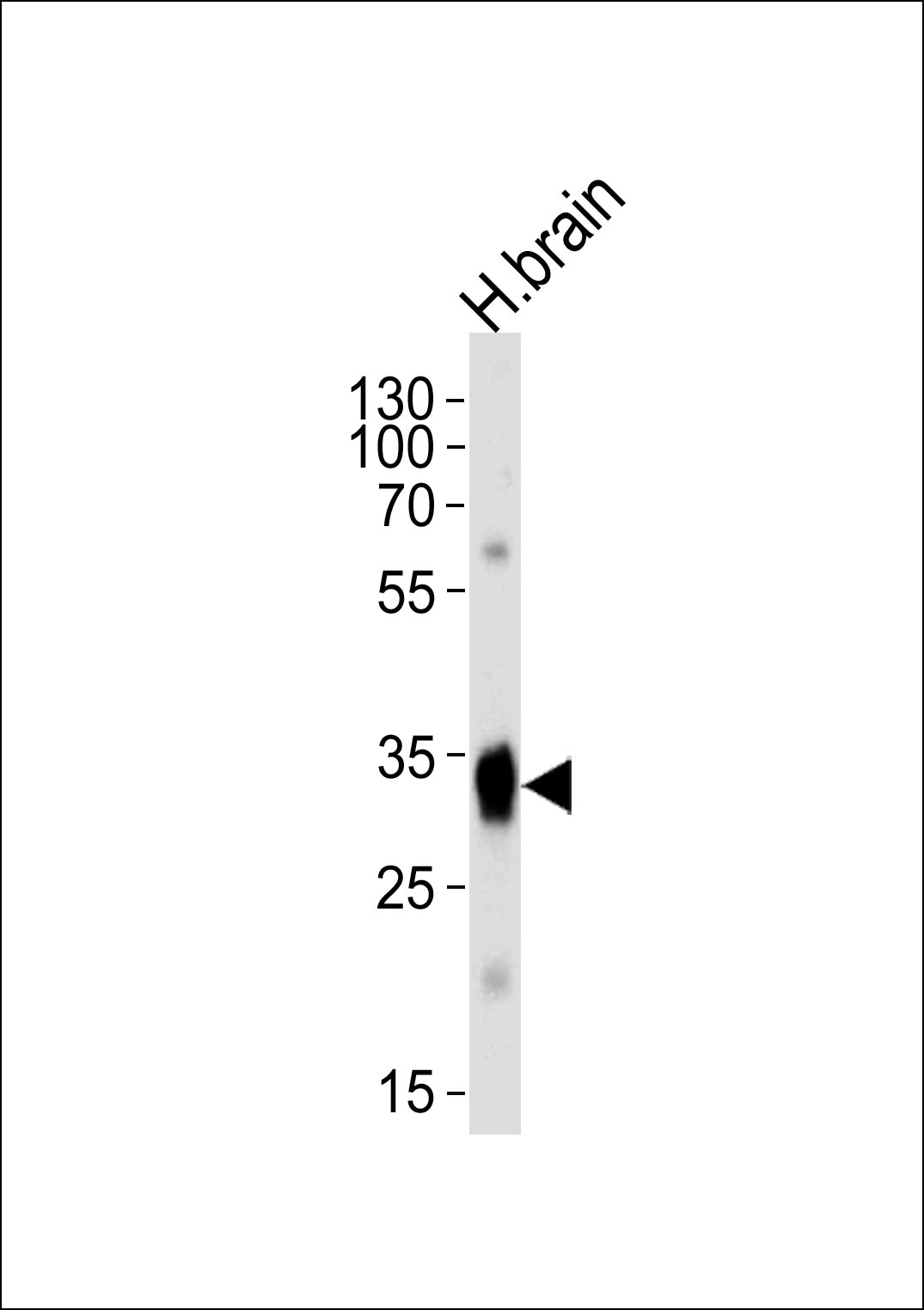SULT4A1a/b Antibody (N-term)
Purified Rabbit Polyclonal Antibody (Pab)
- SPECIFICATION
- CITATIONS
- PROTOCOLS
- BACKGROUND

Application
| WB, E |
|---|---|
| Primary Accession | Q9BR01 |
| Other Accession | NP_795343 |
| Reactivity | Human |
| Host | Rabbit |
| Clonality | Polyclonal |
| Isotype | Rabbit IgG |
| Calculated MW | 33085 Da |
| Antigen Region | 1-30 aa |
| Gene ID | 25830 |
|---|---|
| Other Names | Sulfotransferase 4A1, ST4A1, 282-, Brain sulfotransferase-like protein, hBR-STL, hBR-STL-1, Nervous system sulfotransferase, NST, SULT4A1, SULTX3 |
| Target/Specificity | This SULT4A1a/b antibody is generated from rabbits immunized with a KLH conjugated synthetic peptide between 1-30 amino acids from the N-terminal region of human SULT4A1a/b. |
| Dilution | WB~~1:1000 E~~Use at an assay dependent concentration. |
| Format | Purified polyclonal antibody supplied in PBS with 0.09% (W/V) sodium azide. This antibody is prepared by Saturated Ammonium Sulfate (SAS) precipitation followed by dialysis against PBS. |
| Storage | Maintain refrigerated at 2-8°C for up to 2 weeks. For long term storage store at -20°C in small aliquots to prevent freeze-thaw cycles. |
| Precautions | SULT4A1a/b Antibody (N-term) is for research use only and not for use in diagnostic or therapeutic procedures. |
| Name | SULT4A1 |
|---|---|
| Synonyms | SULTX3 |
| Function | Atypical sulfotransferase family member with very low affinity for 3'-phospho-5'-adenylyl sulfate (PAPS) and very low catalytic activity towards L-triiodothyronine, thyroxine, estrone, p- nitrophenol, 2-naphthylamine, and 2-beta-naphthol. May have a role in the metabolism of drugs and neurotransmitters in the CNS. |
| Cellular Location | Cytoplasm. |
| Tissue Location | Highly expressed in the cerebral cortex and frontal lobe, slightly less in the cerebellum, occipital and temporal lobes, relatively low in the medulla and putamen, and lowest in the spinal cord. No expression detected in the pancreas (PubMed:10698717). Highly expressed in fetal brain and occipital lobe, slightly less in the whole brain, frontal lobe, hippocampus, and lung, very low expression in cerebellum, medulla oblongata, temporal lobe, testis, kidney and appendix (PubMed:12039030). |

Thousands of laboratories across the world have published research that depended on the performance of antibodies from Abcepta to advance their research. Check out links to articles that cite our products in major peer-reviewed journals, organized by research category.
info@abcepta.com, and receive a free "I Love Antibodies" mug.
Provided below are standard protocols that you may find useful for product applications.
Background
Sulfotransferase enzymes catalyze the sulfate conjugation of many hormones, neurotransmitters, drugs, and xenobiotic compounds. These cytosolic enzymes are different in their tissue distributions and substrate specificities. The gene structure(number and length of exons) is similar among family members. SULT4A1 isoforms a and b are selectively expressed in brain tissue. Isoform a is the predominant of the two isoforms of this protein. Isoform b includes an alternate segment, compared to isoform a, that causes a frameshift. The resulting protein (isoform b) has a distinct and shorter C-terminus when compared to isoform a.
References
Liyou, N.E., et al., J. Histochem. Cytochem. 51(12):1655-1664 (2003).
Weinshilboum, R.M., et al., FASEB J. 11(1):3-14 (1997).
Glatt, H., et al., Mutat. Res. 482 (1-2), 27-40 (2001).
Sakakibara, Y., et al., Gene 285 (1-2), 39-47 (2002).
Glatt, H., et al., Toxicol. Lett. 112-113, 341-348 (2000).
If you have used an Abcepta product and would like to share how it has performed, please click on the "Submit Review" button and provide the requested information. Our staff will examine and post your review and contact you if needed.
If you have any additional inquiries please email technical services at tech@abcepta.com.













 Foundational characteristics of cancer include proliferation, angiogenesis, migration, evasion of apoptosis, and cellular immortality. Find key markers for these cellular processes and antibodies to detect them.
Foundational characteristics of cancer include proliferation, angiogenesis, migration, evasion of apoptosis, and cellular immortality. Find key markers for these cellular processes and antibodies to detect them. The SUMOplot™ Analysis Program predicts and scores sumoylation sites in your protein. SUMOylation is a post-translational modification involved in various cellular processes, such as nuclear-cytosolic transport, transcriptional regulation, apoptosis, protein stability, response to stress, and progression through the cell cycle.
The SUMOplot™ Analysis Program predicts and scores sumoylation sites in your protein. SUMOylation is a post-translational modification involved in various cellular processes, such as nuclear-cytosolic transport, transcriptional regulation, apoptosis, protein stability, response to stress, and progression through the cell cycle. The Autophagy Receptor Motif Plotter predicts and scores autophagy receptor binding sites in your protein. Identifying proteins connected to this pathway is critical to understanding the role of autophagy in physiological as well as pathological processes such as development, differentiation, neurodegenerative diseases, stress, infection, and cancer.
The Autophagy Receptor Motif Plotter predicts and scores autophagy receptor binding sites in your protein. Identifying proteins connected to this pathway is critical to understanding the role of autophagy in physiological as well as pathological processes such as development, differentiation, neurodegenerative diseases, stress, infection, and cancer.


